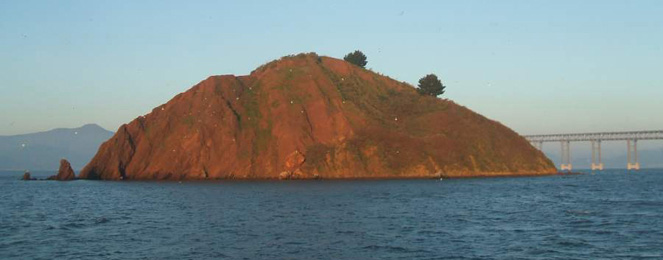Got $22 million to spare? If so, you can purchase a piece of San Francisco Bay: Red Rock. You’ve almost certainly seen it: a tiny, tall island standing just south of the Richmond-San Rafael Bridge.

Red Rock got its name from the manganese in its rock, which was mined for a short time after the Civil War. Mining tunnels are stillvisible on the island’s west side. Photo by Captain Ray Wichmann
By Captain Ray
Published: March, 2011
On a recent morning, we made a trip to Red Rock, departing the Richmond Yacht Club just as the sun was rising. The island lived up to its name, glowing in the early morning sunlight. With a brisk north wind and a strong ebb current setting to the south, we anchored to the south of the island and dinghied up the east side of the island to the red sand beach at the north end.
We considered climbing to the summit, but decided against it because it would disturb nesting birds. (Besides, poison oak is everywhere!) We spent about an hour and a half walking not quite all the way around the island—there is a spot on the southwest side that is impassable. Our group picked up the biggest pieces of trash, marveled at the beautiful but very twisted rock (Franciscan shale, I believe), and enjoyed the views of the Bay from this unique perspective.
Russian and Aleut fur hunters shared this perspective: Red Rock first appears in the written record in 1812 as a camping spot for hunters seeking the once-abundant sea otters. Frederick W. Breechey, a captain in the Royal Navy, drafted the first chart to show the island in the 1820s. He named it Molate Island, a misspelling of the Spanish “moleta,” a stone used for grinding pigments.
Because of (completely unsubstantiated) stories of pirate loot buried on the island, it has also been called Treasure Island and Golden Rock. Periodically, people have dug around on the island, but no treasure has ever been found—no treasure that we know of, that is.
The only person known to have lived on Red Rock was Selim Woodworth, who built a small cabin, placed a flagpole on the summit, and called the island home from 1851 to 1856, despite the lack of a permanent fresh water source. Woodworth tried to claim title to the island under the Homestead Act, but the U.S. Land Office Registrar refused the claim, believing the government might want to fortify it or erect a lighthouse. Neither happened, although the Coast Guard did install a fog signal (now abandoned) on a much smaller rock just to the south.
In the early 1920s, during the Harding Administration, Red Rock was sold to a private party. Title changed hands several times and a variety of plans and schemes were proposed for the island. In 1964, a San Francisco attorney acquired Red Rock for $49,500. In the 1980s, plans were announced to reduce the island’s 172 foot height by half and construct a ten-story hotel and casino on the leveled remainder. The plan included construction of a small yacht harbor on the north side of the island. Power and water were to come from connections to the San Rafael Bridge. Nothing ever came of those rather grandiose plans and, in 2007, the island was put up for sale for $10 million. By 2010, the asking price had risen to $22 million.
Before plunking down your money, you should know that because Red Rock’s peak was once used as a survey point, the counties of Marin, Contra Costa and San Francisco claim slices of Red Rock’s slightly less than six acres. Any proposed project would meet with a horrendous permitting process, not to mention environmental concerns and other interests.
Perhaps it is best left to the birds.
Ray Wichmann, is a US SAILING-certified Ocean Passagemaking Instructor, a US SAILING Instructor Trainer, and a member of US SAILING’s National Faculty. He holds a 100-Ton Master’s License, was a charter skipper in Hawai’i for 15 years, and has sailed on both coasts of the United States, in Mexico, the Caribbean, and Greece. He is presently employed as the Master Instructor at OCSC Sailing in the Berkeley Marina.

